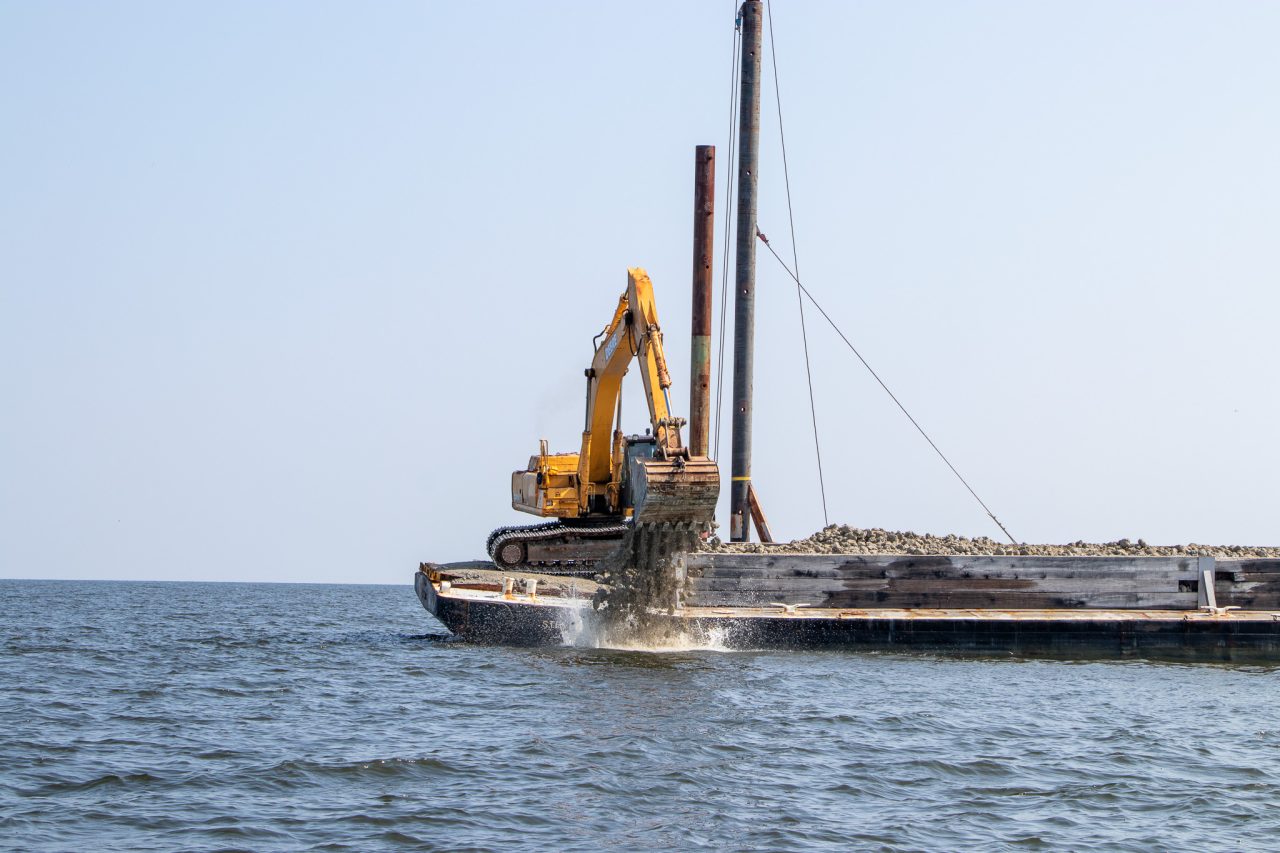Thanks to a $14.9 million grant from the National Oceanic & Atmospheric Administration and a $1 million state appropriation, the Federation is partnering to complete the Pamlico Sound Oyster Sanctuary.
Since 2009, the Coastal Federation and the North Carolina Division of Marine Fisheries have partnered to build oyster sanctuary reefs. The goal is to construct a 500-acre system of reefs that state lawmakers call the Senator Jean Preston Memorial Oyster Sanctuary after one of their Senate colleagues who was a passionate supporter of the effort. This work has received significant financial support from the North Carolina General Assembly and NOAA over the years. Construction of the reefs is managed by the Division of Marine Fisheries, with assistance from the Federation. Private marine and barge contractors, trucking and mining companies, and university researchers are hired to build and then evaluate these reefs.
To date, 423 acres of sanctuary reef have been constructed covering 789 acres of protected underwater habitat. In 2025 and 2026 construction will continue at the newest oyster sanctuary sites: Brant Island and Maw Point. At least 40 acres of new reef will be built each year of this project.


This work is supported by a $14.9 million federal grant from NOAA and an additional $1 million appropriation from the state of North Carolina. The conclusion of this work between the Federation, the Division of Marine Fisheries, and partners will mark the finish of the 500 acres of reef within the Senator Jean Preston Oyster Sanctuary Network in the Pamlico Sound.
The sanctuary system is carefully designed and adaptively managed based on extensive published research. This research shows that the sanctuary reefs now supply a significant quantity of oyster spat that help to maintain and grow productive and sustainable populations of wild oysters throughout the entire sound. Based upon this research and ongoing state monitoring of the constructed reefs, new goals for additional sanctuary acreage beyond 500 acres are likely to emerge as part of the N.C. Oyster Restoration Blueprint planning process; the goals will also be informed by the results of this project.
The Federation and its partners will build 120 acres of oyster reef over the three years of the project. Completing the sanctuary system will require a massive construction effort that will provide direct economic benefits to many coastal communities classified as underserved by NOAA.
The employment opportunities generated by this form of reef construction were documented in reports to NOAA by the Federation when it completed building nearly 50 acres of reefs that were funded in 2009 and 2010 under the American Recovery and Investment Act. This economic study of benefits was updated in 2024. As part of the update, RTI International documented the program’s impressive return on investment, showing that every $1 spent on oyster sanctuary work generates $1.71 in benefits. Between 2013 and 2023, $20 million in public and private funding supported the creation of 159 acres of sanctuary habitat, and 143 additional jobs, and added $34 million to the coastal economy. These sanctuaries enhance water quality, restore habitats, and build a stronger coastal community.
Read the full Economic Impact Study here, or review key insights from RTI International’s report, here.

Training the Next Generation of Oyster Scientists
The grant received from the National Oceanic & Atmospheric Administration and state appropriations will also allow the Federation and partners at North Carolina Central University and North Carolina State University’s Center for Marine Sciences and Technology to collaborate on training the next generation of marine scientists and restoration professionals.
Eight students will be sponsored thanks to this innovative partnership. Through their engagement with the oyster sanctuary project, students will receive graduate school tuition, room and board, stipends, and specialized training such as Open Water and Scientific Diving Certifications. You can read more about these students and the work they are doing, here.

Partners: North Carolina Division of Marine Fisheries, North Carolina Central University, North Carolina State University’s Center for Marine Sciences and Technology, North Carolina Aquarium on Roanoke Island, NOAA Federal, Research Triangle Institute.
Funding Source: National Oceanic & Atmospheric Administration and State Appropriations.

The Restoration Continues
You can support even more oyster restoration by Adopting an Oyster.
